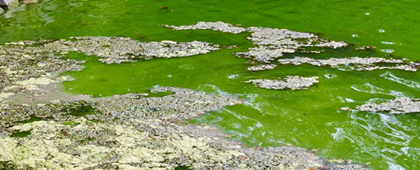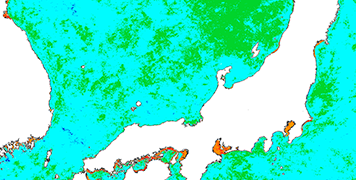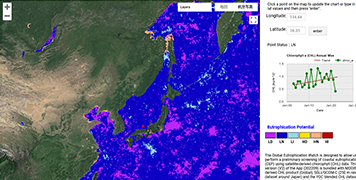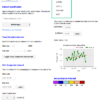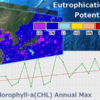Eutrophication is a phenomenon of abnormal increase of phytoplankton and degradation of water quality caused by excessive input of nutrient loads (nitrogen and phosphorus). Eutrophication may lead to occurrences of red tide and/or hypoxia (oxygen depletion) water mass in the sea.
Land-based human activities impact on coastal systems and a large fraction (41%) of the world ocean is strongly affected by multiple drivers [1]. Coastal areas of the Northwest Pacific region, China, Japan, Korea and Russian Fast East, are one of the mostly highly populated areas in the world, and the pressures and demands that this large population brings to bear on the environment are considerable [2]. One response to human activities in the ocean is the accelerated eutrophication caused by increased nutrient loading from farms and cities [3].
Eutrophication is indeed one of the major marine environment issues in the Northwest Pacific region [4], resulting in the occurrence of a significant number of red tides events [5] and formation of large-scale hypoxic areas [6]. Eutrophication can also escalate into transboundary environmental issues with wide spread of abundant giant jellyfish [7] and massive green-tides [8], both of which are triggered by eutrophication. Thus, to address these issues, it is necessary to engage neighboring countries in comprehensive and specific actions to protect the shared environment.
References
[1] Halpern, B., Walbridge, S., Selkoe, K., Kappel, C., Micheli, F., D’Agrosa, C., Bruno, J., Casey, K., Ebert, C., Fox, H., Fujita, R., Heinemann, D., Lenihan, H., Madin, E., Perry, M., Selig, E., Spalding, M., Steneck, R. and Watson, R., “A Global Map of Human Impact on Marine Ecosystems,” Science 319(5865), 948–952 (2008).
[2] UNEP, “Action Plan for the protection, management and development of the marine and coastal environment of the Northwest Pacific region” NOWPAP Publication No. 1 (1997).
[3] Carpenter, SR, Caraco, NF, Correll, DL, Howarth, RW, Sharpley, AN and Smith, VH., “NONPOINT POLLUTION OF SURFACE WATERS WITH PHOSPHORUS AND NITROGEN,” Ecological Applications 8(3), 559 – 568 (1998).
[4] Shulkin, V.M. and Kachur, A.N. (eds), “State of the Marine Environment Report for the NOWPAP region,” POMRAC. 141 p, (2014).
[5] NOWPAP CEARAC, “Integrated Report on Harmful Algal Blooms for the NOWPAP Region”, (2011).
[6] Wei, H., He, Y., Li, Q., Liu, Z. and Wang, H., “Summer hypoxia adjacent to the Changjiang Estuary,” Journal of Marine Systems 67(3-4), 292–303 (2007).
[7] Xu, Y., Ishizaka, J., Yamaguchi, H., Siswanto, E. and Wang, S., “Relationships of interannual variability in SST and phytoplankton blooms with giant jellyfish (Nemopilema nomurai) outbreaks in the Yellow Sea and East China Sea,” J Oceanogr 69(5), 511–526 (2013).
[8] Liu, D., Keesing, J. K., Dong, Z., Zhen, Y., Di, B., Shi, Y., Fearns, P. and Shi, P., “Recurrence of the world’s largest green-tide in 2009 in Yellow Sea, China: Porphyra yezoensis aquaculture rafts confirmed as nursery for macroalgal blooms,” Marine Pollution Bulletin 60(9), 1423 – 1432 (2010).
CEARAC Activity
CEARAC has worked on monitoring and assessment of eutrophication utilizing remote sensing technology. To assess the status of eutrophication in the NOWPAP region, CEARAC developed the “procedures for assessment of eutrophication status including evaluation of land-based sources of nutrient for the NOWPAP region” (the NOWPAP Common Procedure) in 2009. We have implemented case studies to assess the eutrophication status in selected areas of NOWPAP region using this procedure and to verify its validity at the same time. Then, its revised editions were published in 2013 and 2015. For English publications on eutrophication assessment, please refer to the below.
Also, CEARAC has developed environmental monitoring tools. In 2018, we developed the NOWPAP Eutrophication Assessment Tool (NEAT) based on the NOWPAP Common Procedure. This tool can identify eutrophic areas in the NOWPAP region using chlorophyll-a data by combining water quality data collected in the field with ocean color remote sensing data. Moreover, in 2021, we developed the Global Eutrophication Watch, an online application that assesses coastal eutrophication potential (CEP) on a global scale based on NEAT, which is available on the CEARAC website: https://eutrophicationwatch.users.earthengine.app/view/global-eutrophication-watch
・2nd CEARAC Expert Meeting on Eutrophication Assessment in the NOWPAP Region (2019)
・1st CEARAC Expert Meeting on Eutrophication Assessment in the NOWPAP Region (2017)
・4th Expert Meeting on Marine Biodiversity and Eutrophication in the Northwest Pacific Region (2015)
・3rd Expert Meeting on Marine Biodiversity and Eutrophication in the Northwest Pacific Region (2013)
・2nd Expert Meeting on Marine Biodiversity and Eutrophication in the Northwest Pacific Region (2011)
・1st Expert Meeting on Marine Biodiversity and Eutrophication in the Northwest Pacific Region (2010)
・Application of the NOWPAP Common Procedure for Eutrophication Assessment in Selected Sea Areas in the NOWPAP Region (2014)
・Case Study Reports on Assessment of Eutrophication Status in selected sea areas (2013)
・Procedures for assessment of eutrophication status including evaluation of land-based sources of nutrients for the NOWPAP region (the NOWPAP Common Procedure 2013 Revised Edition)(2013)
・Integrated Report on Eutrophication Assessment in Selected Sea Areas in the NOWPAP Region: Evaluation of the NOWPAP Common Procedure(2011)
・Case Study Reports on Assessment of Eutrophication Status in selected sea areas (2011)
・Procedures for assessment of eutrophication status including evaluation of land-based sources of nutrients for the NOWPAP region (2009)
For detailed instructions, see the left panel on the page. You can select “Language” in the panel.


